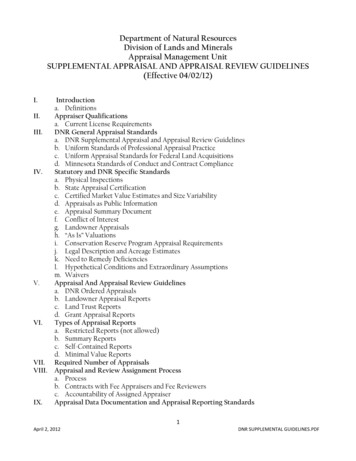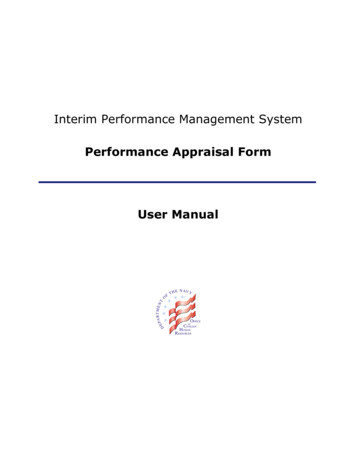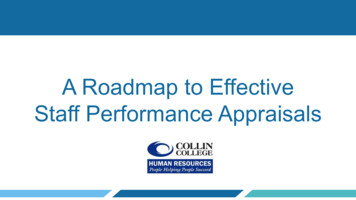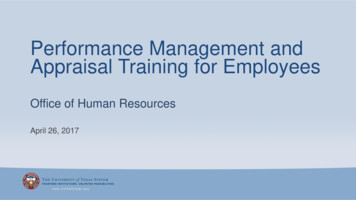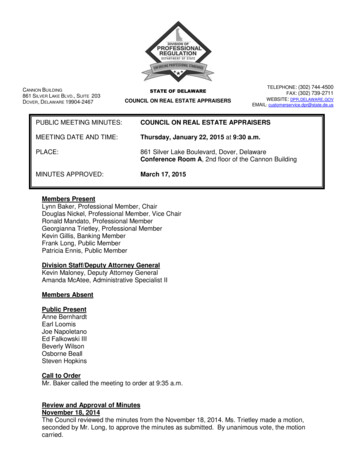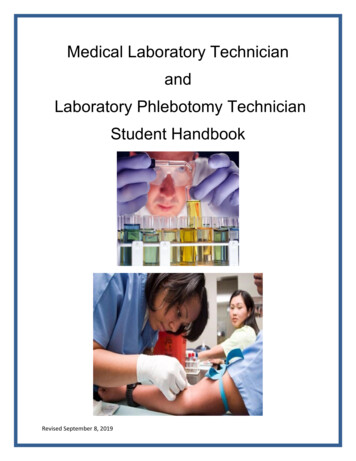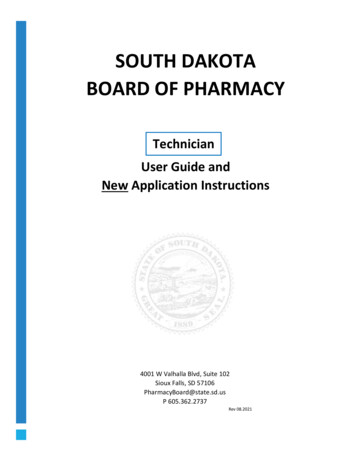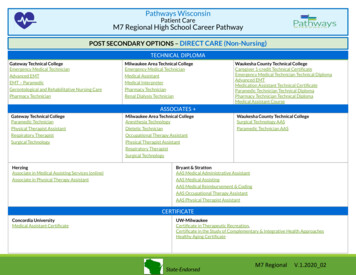
Transcription
ORNGTPR 430Human ResourcesTechnician PerformancePlanning and AppraisalProgramJoint Force HeadquartersOregon National Guard4 September 2013UNCLASSIFIED
Joint Force HeadquartersSalem, OR4 September 2013Oregon National GuardTechnician PersonnelRegulation 430Human ResourcesOregon National Guard Technician Performance Management ProgramBy Order of the Governor:signed byHOKANSON.DANIE DigitallyHOKANSON.DANIEL.ROBERT.1165636739DN: c US, o U.S. Government, ou DoD,ou USA,L.ROBERT.116563 ou PKI,cn HOKANSON.DANIEL.ROBERT.11656367396739Date: 2013.11.22 11:52:17 -08'00'DANIEL R. HOKANSONMajor GeneralThe Adjutant GeneraleOfficial:History. This publicationreplaces previous OregonNational Guard (ORNG)supplements to NationalGuard Bureau (NGB)Technician PersonnelRegulation (TPR)430, The National GuardTechnician PerformancePlanning and AppraisalProgram.Summary. This Regulationimplements and expands onthe processes contained inNGB TPR 430, NationalGuard Bureau TechnicianAppraisal Program and is incompliance with Title 5 Codeof Federal Regulations (CFR)Part 430. It providesguidance for ORNGsupervisors to develop andimplement Performance Plansfor their subordinateTechnicians and evaluateTechnician performance.Applicability. Thisregulation applies to allOregon National GuardFederal Technicians exceptfor Technicians occupyingtemporary positions.Proponent and exceptionauthority. The proponentfor this regulation is theDirector of Human Resources.The Director has authority toapprove exceptions to thisregulation that are consistentwith controlling law andORNGTPR 430 – 4 September 2013regulation. The Director maydelegate this approvalauthority in writing, to DeputyDirector, a branch chief orspecialist in the proponentoffice.Suggested Improvements.Users are invited to sendcomments and suggestedimprovements to: Joint ForceHeadquarters - Oregon,ATTN: J1/HR, PO Box14350, 1776Militia Way, Salem, OR97309-5047.Distribution. Thispublication is availablethrough links on severalORNG web sites or in printmedia, through the HumanResources Office (HRO) at503-584-3975.2
ContentsSection 1 - IntroductionPurpose 1-1, page 4References 1-2, page 4Explanation of abbreviations and terms 1-3, page 4Responsibilities 1-4, page 4Objective 1-5, page 4Section 2 – The Performance Plan, Review and Appraisal ProcessGeneral, 2-1, page 5Five Rating Level Evaluation Method 2-2, page 5Performance Reviews 2-3, page 5Performance Appraisal 2-4, page 6The Annual Performance Management Cycle 2-5, page 8Performance Plans 2-6, page 9Monitoring Performance 2-7, page 9Section 3 – Unacceptable PerformancePerformance Verses Conduct 3-1, page 10Recognizing Unacceptable Performance 3-2, page 10Performance Review Associated with Unacceptable Performance 3-3, page 10The Performance Improvement Plan (PIP) 3-4, page 10Unacceptable Performance after a PIP 3-5, page 11Section 4 – The Review and Appeal Process for Non-Bargaining Unit MembersAppeal Rights 4-1, page 11Technician Actions 4-2, page 11HRO Actions 4-3, page 12State Review and Appeals Board Actions 4-4, page 12Adjutant General Actions 4-5, page 12Appendix A – References, page 13Glossary, page 13Abbreviations, Page 14ORNGTPR 430 – 4 September 20133
Section 1 - Introduction1-1. PurposeThis regulation establishes the Oregon National Guard Performance Planning and Appraisal Program for FederalTechnicians. The program fully integrates organization and mission goals and objectives into the planning andappraisal process. It encourages Technician involvement in the process that is ultimately the responsibility ofthe supervisor to complete. The program provides for the application of appropriate personnel actions based onperformance appraisals.1-2. ReferencesRequired and related publications and prescribed and referenced forms are listed in Appendix A.1-3. Explanation of Abbreviations and TermsAbbreviations and terms used in the regulation are referenced in the Glossary.1-4. ResponsibilitiesIn addition to those responsibilities outlined in NGB TPR 430, the Adjutant General has made the followingpersons responsible for the indicated actions:A. Director of Human Resources will:(1) Communicate with Commanders, Supervisors and Technicians about relevant parts of thePerformance Management Program.(2) Ensure written Performance Plans are established for all permanent Technicians.B. Commanders, Managers and Supervisors will:(1) Aggressively solicit Technician input to Performance Planning and appraisal process’s.(2) Clearly specify in the Performance Plan, the ORNG, unit, and work center objectives theTechnician’s work supports.1-5. ObjectivesThe objectives of the Performance Management Program are well stated in NGB TPR 430, the National GuardTechnician Appraisal Program. These objectives are summarized below with additional ORNG specifics:A. Integrate ORNG, unit, and work center goals and objectives into the performance managementprocess.B. Improving organizational effectiveness.C. Establish accountability for achieving established goals and objectives.D. Establish a record on which to base the following types of personnel actions:(1) Within-grade/Step increases(2) Incentive Awards(3) Promotions(4) Reassignments, Reductions in Grade or Removals(5) Reduction in ForceE. Consistently apply Merit Systems Principles.F. Involve Technicians in the program development, implementation, and application.G. Encourage Technicians to take responsibility for performing to their full potential by:(1) Documenting their objectives for the appraisal plan period(2) Documenting their professional development desires(3) Documenting their long-range career objectivesORNGTPR 430 – 4 September 20134
Section 2 - The Performance Plan, Review and Appraisal Process2-1. GeneralA. The Performance Plan is comprised of all of the written job objectives that set forth expectedperformance. Only Job Objectives (Critical Elements – see glossary for definition) will make up the PerformancePlan. Job Objectives are derived from the Technician’s Position Description. The Performance Plan for aTechnician and a Performance Appraisal together establish a Technician’s rating of record (as referenced in 5CFR 430 or NGB TPR 430). The Performance Plan and Appraisal are documented using the PerformanceAppraisal Application (PAA) tool. The Performance Plan and Appraisal together are required to establish a ratingof record and may be used to justify performance awards. The rating of record is the only performance record thatcan be used to justify a negative personnel action in accordance with (IAW) 5 CFR 430.B. The Performance Review is one tool used to facilitate ongoing communication between the supervisorand Technician regarding performance. Formal Performance Reviews like the Performance Appraisal aredocumented using the PAA. Performance Reviews are not a rating of record and cannot be used to justify anegative personnel action. However, the Performance Review is mandatory to initiate a formal PerformanceImprovement Plan.2-2. Five Rating Level Evaluation MethodA. The five rating level evaluation method is used to provide consistency in describing ratings of recordand as a reference point for applying other related regulations, including, but not limited to:(1) Within Grade Increases/Step Increases (5 CFR Parts 531 and 532)(2) Incentive Awards (5 CFR Part 451)(3) Reassignments, Reductions in Grade or Removals (5 CFR Part 430)(4) Promotions (5 CFR Part 335 and TPR 300(335))(5) Reduction in Force (TPR 300 (351))B. The five rating levels are:JOBOBJECTIVERATING5 – Outstanding4 – Excellent3 – Fully Successful2 – Marginal1 – UnacceptableNot RatedDESCRIPTORS: The following definitions shall apply to the summary oroverall performance appraisal rating:Outstanding performance in one or more job objective and excellentperformance for all other job objectives.Excellent performance in one or more job objectives and fully successfulperformance for all other job objectives.Overall fully successful performance.Below fully successful performance for one or more job objectives, but at leastmarginal performance for all job objectives.Fails to meet at least the marginal performance standard in one or more jobobjectives.Employee did not have an opportunity to perform the job objective because itbecame obsolete or could not be accomplished due to extenuating circumstances.2-3. Annual Performance Management CycleA. Supervisors will implement a Performance Plan, conduct Performance Reviews and complete thePerformance Appraisals in accordance with the instructions above.B. The supervisor is responsible for complying with the performance management timing criteria,realigning off cycle appraisals (coordinate with HRO) and fitting scheduled reviews and appraisals into the overalltraining and operations plan.C. To assist command in monitoring the performance management cycle, the HRO will provide reportsas needed. The following reports are examples of what reports are available:(1) Overdue Performance Plan Report – a list of Technicians, who have been assigned,ORNGTPR 430 – 4 September 20135
reassigned or promoted for more than 30 days and no Performance Plan is posted in HRO.(2) Suspense Report for Upcoming Performance Appraisals – a list of Technicians whose lastperformance appraisal is 10 to 12 months old.(3) Overdue Performance Appraisal Report – a list of Technicians whose last performanceappraisal is over 12 months old.D. Postponement of Performance Appraisals beyond one year from the last appraisal will occur only withHRO concurrence.2-4. Performance PlansA. The supervisor will document the Performance Plan using the PAA, Performance AppraisalApplication tool.B. Establishing the Performance Plan is a joint effort of the supervisor and Technician. The supervisorbegins the plan development process by explaining to the Technician how his or her work contributes to the goalsand objectives of the work element and higher headquarters goals and objectives. The supervisor and Technicianthen develop the body Performance Plan which is comprised of clearly written “Performance Elements”associated with established “Performance Indicators” and “Technician Objectives”.C. The Technician is required to sign the form indicating receipt. The signature does not indicateconcurrence. If the Technician refuses to sign, he/she is subject to disciplinary action. The supervisor willimmediately contact HRO for guidance. If the Technician disagrees with the content of the Performance Planthey may utilize the appropriate grievance procedure to seek resolution.D. Supervisors will implement a Performance Plan within the first 30 days of a Technician beingassigned to a new position, having a new position description applied to the Technician’s current position, orwhen the Technician is detailed to a different position for a planned period of more than 120 days.E. The supervisor will send an electronic copy of the completed Performance Plan to the HRO when theplan is implemented.F. Aligning Performance Plans with Strategic Goals. Performance Plans shall support and align with theDoD mission and its strategic goals, organizational program and policy objectives, annual Performance Plans, andother measures of performance. The DoD mission and goals cascade to the state, and resulting state mission andgoals are the basis for individual performance expectations.G. Performance Expectations may include:(1) Goals or objectives that set general or specific performance targets at the individual, team,and/or organizational level;(2) Organizational, occupational, or other work requirements, such as standard operatingprocedures, operating instructions, manuals, internal rules and directives, and/or other instructions that aregenerally applicable and available to the employee;(3) Particular work assignments or other instructions may be used to amplify performanceexpectations. These work assignments or instructions may specify the quality, quantity, accuracy, timeliness, orother expected characteristics of the completed assignment or some combination of such characteristics. Suchassignments and instructions need not be in writing.H. Developing and Communicating Performance Plans. Communication between supervisors andemployees is critical to the success of the performance management program. Performance expectations and yearto-date progress should be the subject of several discussions throughout the year between supervisors andemployees. At least one documented interim performance review is required.(1) Performance expectations will normally be communicated to the employee in writing within30 days from the start of the rating cycle, entrance on duty of a new employee, or employee job change, but nolater than 120 days prior to the end of the appraisal period. Employees are always accountable for demonstratingprofessionalism and standards of appropriate conduct and behavior, such as civility and respect for others.Performance expectations, even if not stated in a job objective, include the general behavioral expectations for allemployees as stated in the Standards of Ethical Conduct for Employees in the Executive Branch, and the DoDJoint Ethics Regulations.(2) Supervisors and employees should have meaningful dialogue on performance expectations,including but not limited to:a. Job Objectives appropriate for the grade and current salary to which the employee isORNGTPR 430 – 4 September 20136
assigned and how they relate to organizational mission and goals;b. Weight of each job objective, if applicable(3) Performance Plans. Every eligible employee shall be issued a Performance Plan containingthe employee’s job objectives and performance standards. Performance Plans shall be documented in the DefenseCivilian Personnel Data System (DCPDS), utilizing the Performance Appraisal Application tools.a. Performance Plans shall be in place and communicated to the employee normallywithin 30 days from the start of the rating cycle, entrance on duty of a new employee, or employee job change.The 30-day requirement may be extended up to an additional 60 days. Such extension shall not impact or delaythe issuance of a yearly appraisal.b. Higher-Level Review of Performance Plans: The Performance Plan is subject tohigher-level review to ensure consistency and fairness within and across organizations. The Performance Plan isconsidered to be approved after higher-level review and the supervisor has communicated the plan to theemployee in writing. The supervisor shall record the employee’s receipt of the Performance Plan and the mannerin which it was provided (face-to-face, telephone, etc.) to the employee in the PAA.I. Adjustment of Performance Plans during the Appraisal Period. Performance Plans, (job objectives andstandards) should be reviewed regularly. When adjusting Performance Plans, supervisors and employees mustfollow the requirements for planning, communicating, monitoring, and assessing expectations established in thisregulation. Adjustments to Performance Plans shall be in place and communicated to the employee normallywithin 30 days from the start of the rating cycle, entrance on duty of a new employee, or employee job change.J. Job Objectives. Each eligible employee will have their work assignments or responsibilities describedin their Performance Plan as a Job Objective(s) Supervisors are encouraged to involve employees in thedevelopment of their job objectives. Normally, this process will include at least one face-to-face discussionbetween supervisors and employees. Final decisions regarding performance standards, including job objectives,are within the sole and exclusive discretion of management.(1) Each eligible employee shall be assigned at least two and generally three to five jobobjectives. While each employee may have up to a maximum of ten job objectives, best practice is to assign threeto five. These job objectives shall be commensurate with duties and responsibilities assigned to the employee andthe salary paid to that employee. Job objectives may be weighted to reflect relative priority of the elementsincluded in the Performance Plan. No job objective may be weighted less than 10 percent. Weighted jobobjectives must total 100 percent. If job objectives are not weighted they are considered all equal.(2) Job objectives and performance standards should be documented, in the PAA, on theautomated NGB Form 430, in the Job Objectives block.(3) Adding Job Objectives. When new job objectives are assigned (e.g., due to a job change,additional duties, promotion, etc.), they must communicate that portion of a major performance expectation thatcan be accomplished within the time remaining in the appraisal period. Job objectives may not be added orchanged 120 days prior to the end of the appraisal period.(4) Mandatory Job Objective(s) for Supervisors. A supervisor's Performance Plan shall includeat least one supervisory job objective. The mandatory job objective will hold supervisors accountable for carryingout the responsibilities outlined in this regulation, including but not limited to:a. Clearly communicating the Performance Plan and holding employees responsiblefor accomplishing their critical elements and performance standards;b. Making meaningful distinctions among employees based on performance and theemployee’s contributions aligned with the strategic goals and objectives;c. Fostering and rewarding excellent performance;d. Addressing poor performance;e. Assuring employees are assigned a rating of record;f. Adhering to laws and regulations concerning merit system principles and prohibitedpersonnel practices;g. Ensuring continuing application of, and compliance with EEO laws, regulations andpolicy.ORNGTPR 430 – 4 September 20137
2-5. Monitoring PerformanceA. As part of monitoring employee performance, supervisors are expected to:(1) Engage in dialogue with the employee concerning performance(2) Conduct one or more documented interim reviews with each employee(3) Maintain performance information(4) Update job objectives and performance standards if they change(5) Anticipate and address performance deficiencies(6) Reinforce effective behaviorB. Properly monitoring performance enables supervisors to identify, address, and resolve performancedeficiencies during the appraisal cycle. A Level 1 rating of record does not need to be formally assigned to theemployee in order to address a performance deficiency.C. Dialogue and Feedback.(1) Supervisors will provide on-going (i.e., regular and timely) feedback in the form ofmeaningful dialogue with employees regarding their performance. Face-to-face is the preferred method ofsupervisory/employee dialogue for performance based issues. Although supervisors have the primaryresponsibility for providing employees feedback, employees share the responsibility of identifying andcommunicating successes and challenges relative to their assigned Performance Plan.(2) Employees may request periodic feedback and dialogue regarding their own performance.To the extent practicable, supervisors will accommodate such requests.D. Employees on temporary assignment/promotion. Policies established for setting and communicatingPerformance Plans will be applied to the extent practicable. Generally, an employee on a short-term detail,temporary reassignment or temporary promotion during the appraisal period shall be assigned an annual rating ofrecord by the supervisor/rater of the permanent position.(1) At the time of the temporary assignment, the employee, temporary (gaining) supervisor andsupervisor of the permanent position shall jointly review and determine the need to adjust previously assigned jobobjectives.(2) The supervisor of the permanent position has final authority to determine and document theappropriate job objectives and performance plan. Both supervisors will cooperate to ensure that the employee isprovided meaningful feedback during the temporary assignment or temporary promotion and is issued at least onedocumented interim review.(3) The temporary supervisor shall complete a closeout assessment for employees who havebeen assigned to them for at least 120 calendar days.(4) In the case of long-term details, temporary reassignments or temporary promotions, it maybe more appropriate for the temporary (gaining) supervisor to prepare the annual rating of record. To the extentpracticable, the rater and reviewing official will consider the closeout assessment provided by the supervisor ofthe temporary position.E. Interim Reviews. While ongoing informal dialogue and feedback are essential throughout the ratingcycle, one or more formal interim Performance Reviews shall be conducted between supervisors and employees.At least one interim Performance Review shall be prepared and documented during the appraisal period. Theinterim review shall be documented on automated NGB Form 430.(1) A formal interim review shall acknowledge achievements and suggest areas forimprovement, and provide meaningful dialogue and exchange of concerns. Developmental suggestions also maybe provided to the employee, as appropriate.(2) The employee shall be provided a copy of the interim review. Supervisors shall record theemployee’s receipt of the interim review and the manner in which the review was communicated (face-to-face,telephone, etc.).(3) Normally, the immediate supervisor will accomplish the interim review. To the extentpracticable, if the immediate supervisor is unable to accomplish the interim review, he or she shall providemeaningful input to the manager responsible for accomplishing the review.(4) Interim reviews are subject to higher-level review to ensure consistency and fairness withinand across organizations. The interim review is considered to be approved after higher-level review, and thesupervisor has communicated the plan to the employee in writing.F. Closeout Assessment. Supervisors will complete the PAA, giving a brief narrative description ofORNGTPR 430 – 4 September 20138
employee performance, achievements and contributions during the current appraisal period when it is known thesupervisor will cease to exercise duties related to monitoring, developing and rating employee performance (dueto job change, extended absence, retirement etc.) for such employees. This condition may result from a jobchange by either the supervisor or the employee.(1) A supervisor shall prepare a closeout assessment for an employee when it is known theemployee will change positions resulting in a new supervisor. Additionally, a supervisor shall prepare a closeoutassessment, as required, for employees on details or other previously occupied positions, as input for anemployee’s rating of record.(2) A closeout assessment is only required if an employee has been assigned to a specificsupervisor and has been on an approved Performance Plan for more than 120 calendar days.(3) Closeout assessments will normally be accomplished within 10 calendar days after thesupervisor ceases to exercise duties related to monitoring, developing and rating the employee’s performance andshall be considered by the appropriate rating official when determining the annual rating of record.(4) A closeout assessment for an employee that was prepared during the most recent appraisalperiod shall be available for review by the following:a. the employee;b. the employee's supervisor (or rater, if different); andc. responsible reviewing official.2-6. Performance ReviewsA. Supervisors will document Performance Reviews within the PAA.B. Performance Reviews improve communications between the supervisor and the Technicianconcerning performance expectations and results. Performance Reviews can and should be conducted by thesupervisor as many times as necessary. However, a trial/probationary review and Interim Performance Reviewsare mandatory.C. A trial/probationary period review is used by the supervisor to document whether the Technician hasthe qualities needed for permanent Federal government service. The review is mandatory to document thesupervisor’s recommendation to retain or not retain a trial period or probationary Technician. (“Trial” period is theterm used for dual-status Technicians and “Probationary” is used for non-dual-status Technicians).(1) The supervisor will complete the appropriate blocks of the PAA by the end of the 10thmonth of the trial/probationary Technician’s first year of employment and obtain the Technician’s signature toindicate that he or she has been informed of the recommendation. The supervisor then immediately sends a copyof the completed form electronically to the HRO.(2) If the HRO concurs with the recommendation to retain the Technician, the supervisor willcomplete the full performance appraisal at the end of the first year of employment IAW paragraph 2-4.(3) At the end of the 10th month of employment, if the supervisor recommends non-retention,the following will apply. The HRO will evaluate the supervisor’s justification, insuring that the employee wasgiven an opportunity to improve. Between the date of the original recommendation and the end of theprobationary period, the HRO will make a final concur/non-concur decision and coordinate with the supervisor toestablish a termination date if necessary.D. Interim Performance Reviews are mandatory and should occur at a minimum near the middle of theperiod covered by the Performance Plan.2-7. Performance AppraisalA. The supervisor will document the performance appraisal by completing the appraisal in the PAA.B. The performance appraisal is the formal documentation of the supervisor’s assessment of theTechnician’s performance. The Supervisor evaluates the Technician’s performance against the previouslyestablished Performance Plan information contained in the PAA to formulate his or her conclusions and thesummary rating.C. Timing of the Appraisal: The supervisor:(1) Will ensure close out of the Performance Appraisal for a Technician by 30 October (ratingperiod is 1 October to 30 September) or at any time provided the Technician’s Performance Plan has been in placefor a minimum of 120 days. Closeout is accomplished when the supervisor, higher level reviewer, and employeeORNGTPR 430 – 4 September 20139
all sign the Performance Appraisal.(2) Must complete a performance appraisal no more than one year after the Performance Plan isimplemented.(3) Annual performance ratings, to determine a rating of record, may be postponed (withdocumentation of circumstances) when there has been insufficient time to observe the technician’s performance intheir present assignment because:a. The supervisor or the Technician is newly-assigned (less than 120 calendar days);b. The Technician has not been performing the regularly assigned work because ofextended details or absences;c. The Technician has not worked under the Performance Plan for at least 120 calendardays. The postponement should not be extended any longer than necessary to permit 120 calendar days under thePerformance Plan;d. The Technician has been deployed for a long period of time, in which case thetechnician’s last rating of record will be used for all official purposes until the technician returns and is observedfor at least 120 calendar days under an approved Performance Plan.e. Employees who are absent at the end of the appraisal period due to a work-relatedinjury. Eligible employees who are still on agency rolls at the end of the appraisal period but who are absent dueto a work-related injury will be rated based on the work performed during the appraisal period, provided they havesatisfied the minimum 120 day performance period. The performance appraisal program procedures described inthis regulation shall be observed to the extent practicable.(4) Must complete “close-out” performance appraisals. Supervisors will complete a close-outappraisal for all subordinates Technicians they have supervised for at least 120 days when the supervisor leavesthe supervisory position or when the technician is given another supervisor or given a new Performance Plan.D. The supervisor will discuss the appraisal with the Technician and fully explain his or her rationale forthe ratings and comments.Section 3 - Unacceptable Performance3-1. Performance Verses ConductA. This section addresses actions that must be taken by Command, the Human Resources Office, theimmediate supervisor and the subordinate Technician when the Technician fails to meet the criteria needed to berated fully successful in the performance elements of the Performance Plan.B. This section does not address inappropriate conduct by the Technician. Supervisors should refer toNGB TPR 752, Discipline and Adverse Action, to address inappropriate conduct issues.3-2. Recognizing Unacceptable PerformanceA. Commanders and Supervisors are responsible for monitoring the work of their subordinateTechnicians and helping them succeed. When the supervisor sees signs of unacceptable performance, he or shemust take steps to help the Technician meet the standards of the Performance Plan.B. With a well written Performance Plan and expectations that are understood by the subordinateTechnician, the supervisor and Technician should be able to discuss performance issues in a non adversarialmanner.3-3. Performance Review Associated with Unacceptable PerformanceA. When the supervisor first sees signs of unacceptable performance, he or she will conduct an interimPerformance Review with the Technician to begin the process of helping the Technician improve. The supervisorwill use the PAA to document the Performance Review.B. If the Technician is not meeting the standards of any job objective of the Performance Plan, thesupervisor will discuss with the Technician the need for a Performance Improvement Plan (PIP) and follow thePIP process described in paragraph 3-4 below. The supervisor should remind the Technician that a PIP is not aroadmap to termination but will be designed to clearly explain expectations and training needs so the Technicia
B. The Performance Review is one tool used to facilitate ongoing communication between the supervisor and Technician regarding performance. Formal Performance Reviews like the Performance Appraisal are documented using the PAA. Performance Reviews are not a rating of record and cannot be used to justify a negative personnel action. However, the .
